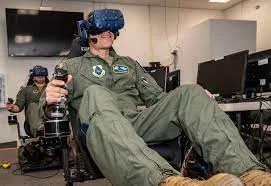The US Army is testing a laser and kinetic weapons in a virtual war environment
With the aim of exploring the complementarities between directed energy concepts and conventional weapons on the future battlefield, the United States Air Force Research Laboratory (AFRL) last January conducted an experiment with the concept of directed energy and kinetic energy, called “Dickey Deuce.” (DEKE DEUCE), according to a press release.
With the advent of drones and electronics in warfare, the nature of battles has changed radically. Militaries around the world are increasing their bets on these advanced technologies as conventional firepower no longer suffices to counter threats, the US Army has made some progress in deploying directed energy weapons systems and the Air Force Research Laboratory is testing its strategies in virtual environments.
According to the press release, the US Armed Forces collaborated with the Ordnance Directorate at Kirkland Air Force Base last January, where pilots, weapons systems officers, and air battle managers have used both directed and conventional energy weapons in various mission groups.
Without revealing too many details, the Air Force Research Laboratory said the airborne high-powered laser pod and two kinetic weapons concepts were tested during virtual exercises.
“It gave Dickie Deuce a great opportunity to put our technical weapons concepts before the fighter,” said Rusty Coleman, technical advisor to the Ordnance Directorate. “It allowed us to see new employment concepts that we wouldn't otherwise have seen. The pilots flying the aircraft almost gave feedback beyond what had been We can get it from anywhere else."
Integration of capabilities and acceleration of development
The Air Force Research Laboratory has also deployed Weapons Engagement Optimizer (WOPR), an artificial intelligence (AI)-based battle management system. Also joining the test was the US Navy's Elctra Battle Management System, which will allow the two forces to coordinate their efforts and integrate their capabilities in the future.
Experimenting with weapons in virtual environments allows for rapid development of technologies, saving valuable resources and costs.
“Experiences like Dickie Deuce allow for important collaboration between the fighter and developers of our future capabilities,” said Col. Matthew Crowell, the Air Force’s chief of flight safety and commander of the pilots who participated in the virtual trials. with technology.”
Features of the drone that will work with the US Army soon
The US military has awarded a California-based drone manufacturer Skydio a $20 million-a-year contract as part of its effort to move away from foreign-made, commercially available drones.
The company revealed - in a press release - that it will provide its X2D drones with the US Army's short-range reconnaissance program known as "SSR".
The program aims to provide soldiers with rapidly deployable aerial solutions that can conduct surveillance and reconnaissance activities at short ranges, the SSR program was considering the use of small drones, more than 30 vendors submitted their bids to the military, and 5 finalists were selected for rigorous testing.
The minimum specification of the SSR program includes a flight time of at least 30 minutes, a range of 1.86 nautical miles (3 km), and the ability to withstand winds of up to 15 knots.
With the sole purpose of reconnaissance, the drone does not need interchangeable payloads, but must support mapping missions and the ability to geotag images.
The Skydio X2D drone features dual-color thermal-optical sensors capable of capturing 4K video clips, and is equipped with GPS-based night reconnaissance equipment. Which makes it suitable for various operations around the clock.
The drone has a flight time of 35 minutes at a top speed of 25 mph (40 km/h), and uses artificial intelligence features to avoid obstacles and detect the target.
The aircraft's light weight makes it easy to use and carry, weighing just under 3 pounds (1.3 kilograms), and has the ability to fold itself and reduce its dimensions. The company says the folded plane can be prepared for take-off in less than 75 seconds.
The console weighs a few hundred grams and comes with a screen that can transmit 720p video clips while connected to the drone within a 4 miles (6 kilometres) range.
In addition to its technical capabilities, an important consideration that likely gave Skydio the advantage is that its drones are “designed and assembled” in the United States. In 2017, the US military banned the use of drones from the famous Chinese company, DJI. In this area due to security concerns, the military took another step last year to ban drones or their subsystems obtained from hostile countries.
However, this is not the first purchase of small drones the US military has made. In June 2020, the military also placed an order for pocket-sized drones that weigh barely an ounce (33 grams) and have a flight time of 25 minutes.




